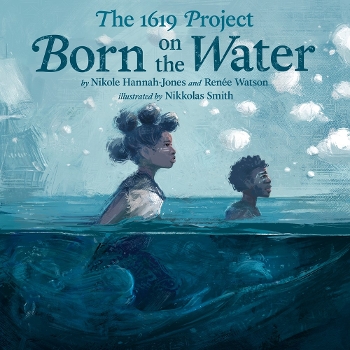Using the year 1619 as a cultural milestone that introduced a shift in perspective on America’s origin story, Born on the Water was bound to be a groundbreaking picture book. The only surprise is that, as thrilling as it was expected to be, this picture book exceeds expectations.
 Using the year 1619 as a cultural milestone that introduced a shift in perspective on America’s origin story, Born on the Water was bound to be a groundbreaking picture book. The only surprise is that, as thrilling as it was expected to be, this picture book exceeds expectations.
Using the year 1619 as a cultural milestone that introduced a shift in perspective on America’s origin story, Born on the Water was bound to be a groundbreaking picture book. The only surprise is that, as thrilling as it was expected to be, this picture book exceeds expectations.
Putting art to poetry in a children’s book that blends historical nonfiction with fiction is a special task, requiring a level of detail, emotion, energy, and storytelling to bind the work together through art. That is just what Nikkolas Smith achieves through his illustrations for Born on the Water. Smith’s illustrations excel at conveying emotion through a range of vivid facial expressions depicted in varying degrees of detail, along with dynamic compositions in a shifting palette to render intense moods.
The fictional narrator’s perplexed discomfort is the focus at the beginning of the book, with a close-up of a brown girl’s concerned face. Once Grandma sits the family down to tell them where they come from, the focus shifts to the joyful freedom of their ancestors. These spreads exude energy, offering sensory pleasures that jump off the page — peaceful weather and rhythmic sounds — as they draw the reader into bright scenes of activity and loving interaction. Natural landscapes and earth-toned buildings extend beyond the page around the characters, showing a people at harmony with their surroundings.
When kidnapping and slavery disrupt the community, the environment itself turns eerie: the dark of night and shadow, the red of dawn, the silhouettes of people being moved like cattle, all take on a threatening feel. The ocean itself is black when carrying the ship — but blue when welcoming those who couldn’t bear the pain. While many of us are used to seeing charts of bodies on slave ships, Smith makes us intimate with the captives, dwelling in the darkness with them, with close-ups of their faces as they support one another and survive.
From tragedy and suffering comes the rebirth of a new people, and this stage is marked by darkness and light, toil and dream. As the people emerge into a new day, the blue palette returns. With “Resist,” figures struggle and search in an active spread, reaching forward, breaking chains and hoisting flags as the blue sky blends into a violet wave carrying unknown crowds. With “Legacy,” recognizable figures from African American history emerge from the water with symbols of American society as their background in faded blue and white. The Statue of Liberty in the background echoes an athlete with a raised fist in the foreground. This is America, the image says, just as powerfully as the poetry does.
While many books about the Black experience in the Americas focus on hardship and struggle, this book widens the lens to emphasize who we were before we were “stolen,” and the visual effect of seeing Black families in Africa smiling, laughing, singing, hugging, and dancing is incredibly healing. The spreads about the horror of the kidnapping and the journey on the ship White Lion are put in their proper place: sandwiched between days of glory and days of strength and rebuilding.
By the final page, Smith’s art accomplishes a unique, difficult, and important cultural feat: by expressing the expansive humanity of a people’s history and journey, it changes the meaning of the flag of the United States of America. The narrator’s sense of pride in her people is manifest on her beautiful face, transformed into a smile that speaks volumes, as she colors the stars and stripes of “the country that my ancestors built . . . [and] that I will help build, too.” This culminating moment, the renewed sense of ownership for the symbol that is the American flag, makes this book an unforgettable experience.
[Read the Horn Book Magazine review of Born on the Water.]
RELATED
ALREADY A SUBSCRIBER? LOG IN
We are currently offering this content for free. Sign up now to activate your personal profile, where you can save articles for future viewing.







Add Comment :-
Be the first reader to comment.
Comment Policy:
Comment should not be empty !!!